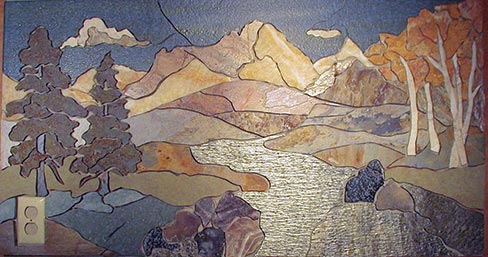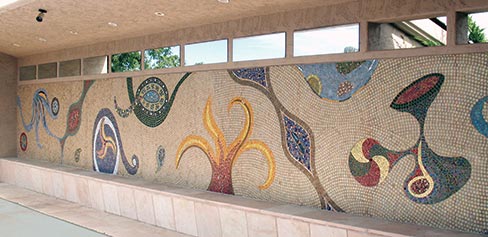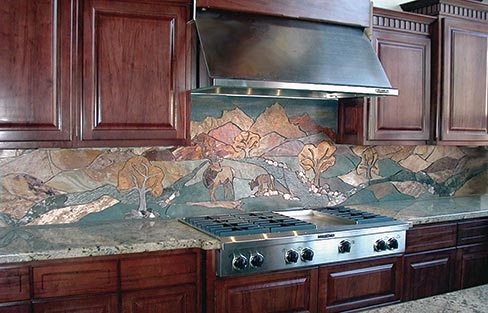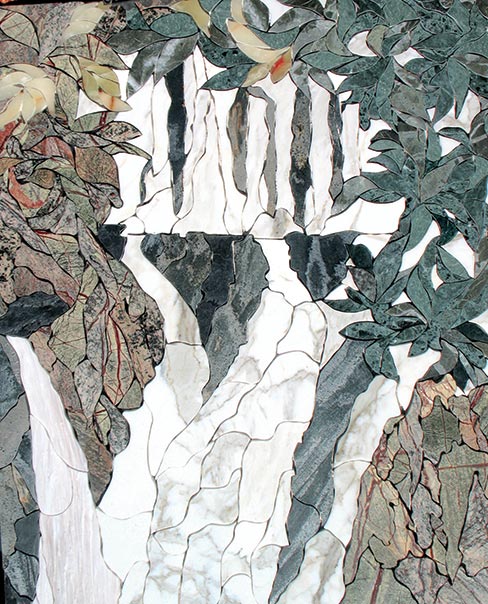Success by Design: Stone Mosaic and Mural Artist Emily Tholberg
Peter J. Marcucci
Special Contributor
 When I first learned about Artist Emily Tholberg, it was just by chance. I had never come face to face with her nor her work until one day I met her family, who then enthusiastically recommended I check out her website –and so I did.
When I first learned about Artist Emily Tholberg, it was just by chance. I had never come face to face with her nor her work until one day I met her family, who then enthusiastically recommended I check out her website –and so I did.
 When you’ve worked with stone for any length of time, you notice things when viewing unique stonework. In this case it was the meticulous use of perspective to highlight a focal point, no matter the difficulty, and the curious way in which the artist blended her colors and shapes while tying it all together. Lastly, the way the final work strikes you while standing back to take in its beauty. Emily’s work has it all.
When you’ve worked with stone for any length of time, you notice things when viewing unique stonework. In this case it was the meticulous use of perspective to highlight a focal point, no matter the difficulty, and the curious way in which the artist blended her colors and shapes while tying it all together. Lastly, the way the final work strikes you while standing back to take in its beauty. Emily’s work has it all.
 Emily began her artistic career as a computer graphics professional, a line of work that took her to over 40 countries on nearly every continent. Residing in Pagosa Springs, Colorado, for almost two decades, she has been producing fine stone art since 1996.
Emily began her artistic career as a computer graphics professional, a line of work that took her to over 40 countries on nearly every continent. Residing in Pagosa Springs, Colorado, for almost two decades, she has been producing fine stone art since 1996.
“In the late 1970s, I worked as a computer graphics artist in the television industry,” explained Emily. “My family owned Dubner Computers, and I was the resident artist putting together graphics to demonstrate and train potential customers within the television industry. Computer animation was just beginning, and Dubner Computers was one of the pioneers. It was a two-dimensional way for me to express three-dimensional art, and I got to do a lot of animation, such as painting and graphics.
 “At about the same time I had met my soon-to-be husband, Stephen Tholberg, who was a very talented builder and could build anything, from a house, to doing tile and stonework. That was 1993, and at that point, after doing some freelance work in Los Angeles, I was finished with the graphics world.”
“At about the same time I had met my soon-to-be husband, Stephen Tholberg, who was a very talented builder and could build anything, from a house, to doing tile and stonework. That was 1993, and at that point, after doing some freelance work in Los Angeles, I was finished with the graphics world.”
 (Note: Dubner Computers was the designer and builder of the groundbreaking “CBG” and later, “The Graphics Factory” computer graphics systems. Both were whole system computers that used hardware and software developed by Dubner Computer engineers and programmers at a time when PC platforms were in their infancy. In their day, both systems won Emmy Awards for outstanding achievements in technology).
(Note: Dubner Computers was the designer and builder of the groundbreaking “CBG” and later, “The Graphics Factory” computer graphics systems. Both were whole system computers that used hardware and software developed by Dubner Computer engineers and programmers at a time when PC platforms were in their infancy. In their day, both systems won Emmy Awards for outstanding achievements in technology).
 By 1995, Emily and Steven had moved from California to Pagosa Springs, Colorado, and were living in their new home. Pagosa Springs was a booming town with clean air and blue sky and much different from the hustle and craziness of Los Angeles.
By 1995, Emily and Steven had moved from California to Pagosa Springs, Colorado, and were living in their new home. Pagosa Springs was a booming town with clean air and blue sky and much different from the hustle and craziness of Los Angeles.
Moving there, according to Emily, seemed like the logical choice after having a high-pressure job. Soon after, the couple decided to tile their kitchen countertop but decided they didn’t want to just buy a homogeneous color tile and install it.
 So Emily, now on a mission, began exploring different ways that might help embellish the tops and bought all kinds of tile rejects and leftovers of different sizes from a local tile store, and for the next two days she created sort of a modern day art compilation using different colors and cutting them with a tile saw that Stephen had brought home.
So Emily, now on a mission, began exploring different ways that might help embellish the tops and bought all kinds of tile rejects and leftovers of different sizes from a local tile store, and for the next two days she created sort of a modern day art compilation using different colors and cutting them with a tile saw that Stephen had brought home.
That was 1997, and was the point when Emily successfully transitioned from a two-dimensional screen and keyboard to a hands-on three-dimensional form using tools, thin set and mortar. Her success continued as she began breaking ground, or should I say “breaking tile,” in pursuit of a new form and profession that, unbeknownst to her, was destined to be a smashing success.
“It was a new and exciting medium for me, and after I did our countertop, I started fooling around with an old dining table. I was sitting on the floor smashing up tile with a hammer, and making smaller pieces no bigger than a thumbnail and gluing them to the surface of the table.
“The many star-shaped formations included little found objects like earrings and jewelry. That was a fun exploration into shapes. I later found out there were names for all of those shapes, and that the Greeks and Romans had been doing those shapes with mosaics thousands of years ago.
“I still have that table, and it’s called the Universe Table. After making it, I just looked and thought, ‘Wow– that’s pretty!’ I had also received compliments from friends who also mentioned an art exhibition building that the town uses every month to display the work of local artists.
‘You could make a few things and display them there!’ they said. So I made a few small mirror frames using leftover slivers from a friend’s marble kitchen and displayed them and even sold a few. That show brought a lot of attention to my work, and soon after, a friend hired me to build her a mosaic countertop. That was in 1998, and that countertop was my first professional job.”
In the midst of a major career moment, Emily’s work continued to evolve, as did her style, and by 2002, her tile-paved countertop work had morphed into backsplashes containing undulating mountains, majestic rivers, and wildlife—lots of wildlife.
“No doubt the great landscapes of Colorado had taken hold of your imagination and had a great effect on your work at that time?,” I asked. Emily answered, now bending the conversation to her current genre of work.
“When I made Moenkopi Canyon, I was inspired by another artist’s work. He was a painter, and I wanted to translate that image into stone. That mural was thirteen feet long, and I didn’t have enough room to set the whole thing up, so I had a portion of it sitting on top of the washing machine, a portion on the table and another portion on yet another table.
“I would stand on boxes and crawl around trying to work on each section. I was just beginning, and it takes a lot of time to get a project of this size going. Trying to cut and fit the different colors while seeing them in my mind’s eye took a lot of time, too.”
 Emily attributes much of her success to the fact that when her art is viewed, “People feel something,” but adding that the biggest key to her success was her ability to push in new directions while knowing how to integrate a clients input with her own.
Emily attributes much of her success to the fact that when her art is viewed, “People feel something,” but adding that the biggest key to her success was her ability to push in new directions while knowing how to integrate a clients input with her own.
“My artistry of landscapes continues to evolve, and most who know me and my work, see this. I want my clients to have their dreams come true and spend as much time with them to understand their needs.
“I then look, and look, and look at each tile or stone while balancing the colors and shapes and touching everything. It’s always a study in perspective, and cutting pieces that can translate that perspective, especially while using bigger pieces, is a challenge for me.
 “When I’m finished, I’m glad to let it go because clients are very excited that it’s done, and they’re eager to finally have it. Murals do take a lot of time and I will not sacrifice quality just to get it done. That mural will be displayed for a much longer time than it took me to create it.”
“When I’m finished, I’m glad to let it go because clients are very excited that it’s done, and they’re eager to finally have it. Murals do take a lot of time and I will not sacrifice quality just to get it done. That mural will be displayed for a much longer time than it took me to create it.”
New and Creative Spaces
Emily’s new shop is six hundred square feet of well-organized work space and includes a Diamond Tech DL 5000 band saw for fine cutting and a Diamond Tech DL 7000 for cutting harder stones or larger pieces. A four-by-eight foot table for layout and gluing is strategically placed to facilitate working all sides of projects under construction.
Correct lighting was also of paramount concern, so care was taken to stream in as much natural light as possible, thereby illuminating her work surface as well as shelves holding tiles in progress. According to Emily, those windows are also an inspiration. “Natural lighting is so important, and I now have plenty of it.
“I really enjoy looking at the view I have from my new work area—the sky, the trees, the mountains. For many years my work had been done in my basement using halogen lights. So I’m really happy to be in this well lit and well ventilated work place.”
There is no water recycling system. It’s just not needed. Nor is there any landfill created. That’s because the many ceramics, stones, and minerals used, that would have eventually found their way into local landfills, are continuously saved and repurposed.
She also uses semiprecious stones from a local rock hound, and found objects such as ceramic tiles and stained glass. “Nothing is in stock in Pagosa Springs, and everything has to be ordered, so I’ll drive to the high-end tile stores in Albuquerque or Durango and pick through their pallets of leftovers in search for interesting colors.
“After I finish a piece, I usually have leftovers, such as small cuts or ends with wiggles and waggles that I didn’t use. I’ll put them in boxes, and in the back of my mind I know that I have them. Eventually, everything gets used.”
Marketing, Sales, and Everything After
Emily’s clients are mostly homeowners, so from time to time she’ll visit local homebuilders and speak to the receptionists. Usually, they know who they are building for and know if a client is looking for something unique. Many times they will ask for a brochure. She also attends home shows in Pagosa Springs and Durango when they become available.
“It’s a funny thing. I can be at one of these shows for two days, displaying my work and mingling with the people, and just get one customer, like the woman that purchased the Moenkopi Canyon mural.
“Another time, I was the featured artist at the Durango Home Show. They used my work on posters and banners and also wrote a story about me in the newspaper. That show turned me on to a client that was delighted to have me do her work. I also have a website where interested people can see examples of what is possible.
“Sometimes clients want something similar to what they’ve seen in my portfolio or might have something new in mind, which is always welcome. Then, after discussing the size and shape they want – usually it’s a custom size – I’ll create a basic sketch and, upon approval, they will send a deposit. I’ll then begin to cut and fit the many hand-picked pieces of quartzite, marble, slate, glass or travertine and thin-set them to cement board.
“I can ship a mural that is three feet long, but if the mural is any larger than that, I will build it in sections. I’ll then take the pieces that crossover the sections (seams) and number them as well as number the instructions. The mural and instructions are then professionally packed into a wooden crate and shipped, fully insured, to the jobsite.
“Upon arrival and unpacking, the instructions say to dry fit the mural first to check for any adjustments needed before gluing. If necessary, I’ll also talk to the tile guy or installer to make sure he’s onboard with the way it needs to be assembled.
“When the mural is received, dry fitted and installed, the installer can then just glue on those crossover pieces to finish the assembly. Variations in countertop thickness as well as cabinets being out of square or varied in size is always challenging, and I may not be there to check it myself — so I will also have conversations with the builder to make sure we’re on the same page.
“It’s not like I’m working in the dark. Usually the installation is smooth and the homeowners are happy. If the jobsite happens to be within a day’s worth of driving time, I will deliver and install it myself.”
The Future
“We live in a world where so many things are made in factories with no personal touch. I am doing something that’s created by hand with the beholder in mind, and I would like people to know that if they want something beautiful and something that can be enjoyed forever, I can do it.
“I would love to have more fabrication shops and designers call me with their ideas, or they can review mine. Many fabrication shops, designers and homeowners don’t know where to go for this type of work, and they really should have my portfolio.
“Even though I’m just a small company, I’ve created and installed many large-scale commercial projects, and I stand poised and ready to do big things for the hospitality market — things that stand out. But on the other hand, I continue to be inspired to keep working with homeowners and designers on their ideas that they’d like to become real, and I will continue to keep taking one step forward, and making things that are totally unique. My work is not just a bunch of cut tile — they are works of art, and I want clients to be delighted with what I make. I’m am one hundred percent focused on customer satisfaction.
“I’m currently working on a backsplash, but instead of it being a rectangle or square, it’s a tree that grows out of a granite countertop alongside a 3-foot window, eventually topping out at 59 inches. A large, graceful branch then traverses the top of the window and gently drifts down the opposite side, creating a surround affect. This homeowner also happens to have a bunch of very cool minerals that I’m using in this backsplash. It is very unique, to say the least.”
Note to Fabricators, designers, and builders: Demand by clients wanting something different is on the upswing. Emily’s work is as gentle and colorful as she is gentle and colorful. She was born in love with art and romances her stonework with enthusiasm, love, and passion–and she takes commissions. For more information visit www.emilytholberg.com
Peter J. Marcucci has over 25 years of fabrication experience in the stone industry. Send your comments to our Contacts page.